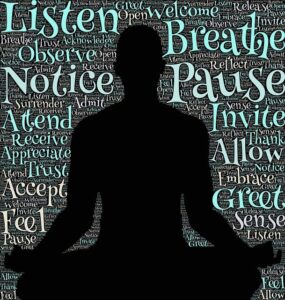Kill Zoners – Please welcome a most-helpful guest post from my good friend and long-time writing colleague, C.S. (Susanne) Lakin, who hosts the popular craft site Live, Write, Thrive.
_ _ _
Settings in fiction are often a mere mention. Characters are talking and doing things, but often readers get a glimpse of the setting via a few lines of description and a dash of sensory detail on the side—and call it good.
A character enters a building in some unidentified place (town, countryside, the Moon?) and goes into a room that has no description whatsoever. Or, if there is some description, it’s more like a laundry list than a place personally experienced by the character and colored by their perspective and mood.
The character walks outside, where there is no notice of weather or time of day or season. The reader can’t see the neighborhood or the environment. The character doesn’t seem to notice or react to where he is.
Truth is, if a writer doesn’t care much about setting, the reader won’t either.
Is that a problem? Maybe not for some readers. But most people will agree that the task of a fiction writer is to immerse her readers into her story. And story is setting. Characters have to be somewhere while they are talking, thinking, and engaging in action.
Setting can be functional and boring. Or it can be powerful in the hands of a master. It behooves fiction writers to become masterful wordsmiths in order to build compelling worlds.
 Chances are, you’ve heard of deep point of view. Imagine a camera lens that zooms in for a close-up. Deep POV is when the description filters directly through the point-of-view character on an emotional level in real time.
Chances are, you’ve heard of deep point of view. Imagine a camera lens that zooms in for a close-up. Deep POV is when the description filters directly through the point-of-view character on an emotional level in real time.
When readers see what the character sees and feel what he feels, it allows for intimate interaction and creates a shared experience in which the story comes alive through the character’s senses, thoughts, beliefs, emotional focus, and judgments.
Not every story uses deep POV, but all writers need to work to create a level of closeness between the character and reader, which requires a deft hand to bring about. The setting is the story element that facilitates this.
Experiencing details about the setting through the protagonist’s emotions and senses makes the reader feel truly part of the story. This means that choosing the right setting for each scene is important to not only help events unfold but increase reader-character connection.
Don’t Opt for Blah Settings
Settings work best when they include an emotional quotient. This is where the setting has a specific emotional resonance to the protagonist and possibly other characters. It holds meaning in some way, or acts as a symbol, charging up the scene. I call these powerful types of settings “connected settings.”
For example, it may be that the setting is connected to some past life event and serves as a reminder of what happened as well as triggers feelings associated with it. Imagine a character being asked to an important business lunch in the same restaurant where his girlfriend turned down his marriage proposal. Even though time has passed, maybe years, an echo of that hurt and rejection will affect him while he’s there and, in turn, will influence his behavior.
Choosing a setting that evokes an emotional response is important since a character’s feelings about his environment add realism and tension to the scene while drawing readers in.
Does your protagonist, for example, have a strong emotional connection to one or both parents (who may still be living or have died before your story starts)? By having your character visit a place that holds powerful memories of that parent, positive or negative or both, those emotions can drive a scene, and the memories triggered there can induce conflict.
Let’s say your protagonist has just had a huge fight with her mother over the man she plans to marry. She might drive back to her childhood home or go sit in the bedroom in her parents’ house in which she spent her childhood. There, she might remember the vicious fights her parents had before they divorced and how painful they were to listen to. She might, at that moment, feel a strong determination to never be like her mother. Or, she may suddenly be afraid to commit to marriage, fearing her marriage may end up just like her parents’.
How to Create Connected Settings
So how do we go about creating connected settings? The first step is to brainstorm the best setting match for a particular scene. This is achieved by looking at what will happen in the scene and which emotions are at play.
Think of a scene you need to write. Then follow these steps:
- Identify your hero’s scene goal—what must he do, learn, or achieve? What do you want him and the other characters involved to feel at the start of the scene.
- Once you know the answers to these questions, brainstorm different types of settings where this scene might take place, ones that fit the story and are logical locations for your character to visit. Consider what issues your character is dealing with and what kind of environment might escalate inner and outer conflict.
- Make a list of the scenes with the most potential. Often the settings that pop immediately to mind are the most obvious, but with a bit of digging, some more creative and interesting choices can be unearthed.
- Once you have a few options, look at each possible setting in turn and think of how you can describe the location to evoke a specific mood that will make your character’s emotional reactions more potent. Tension can be a factor too. Depending on what is about to happen in the scene, you might want your character to feel off-balance. Or maybe you wish to lull him into a false sense of security so he doesn’t see what’s coming. Either way, the details you pick to describe the setting will help steer his emotions.
- Think about what the character will learn, decide, or do as a result of what happens in the scene. The setting can act as an amplifier for this end result simply by surrounding the character with emotional triggers that will lead him to that high moment at the end of the scene.
- Think of how your character will change by the end of the scene and if this means a shift in mood or perspective. Consider how the setting can play a part in that mood shift.
Choosing a strong setting for the scene and then seeding it with triggers creates a push-pull effect, one that amplifies a character’s internal struggle. Through his interaction with the setting, we can home in on the needs, desires, moral beliefs, fears, and personal biases that drive his behavior. How the protagonist reacts to these triggers can allude to past experiences that may still have power over him in the form of emotional wounds.
Go through all your scenes and consider the setting. Consider how you might change or alter your setting to give it more emotional quotient, to impact your characters more strongly. Then dig in and rewrite. You and your readers will be glad you did.
Have you chosen a powerful connected setting for one of your scenes? Share about it in the comments.
_ _ _
 C.S. Lakin is an award-winning author of more than 30 books, fiction and nonfiction (which includes more than 10 books in her Writer’s Toolbox series). Her online video courses at Writing for Life Workshops have helped more than 5,000 fiction writers improve their craft. To go deep into creating great settings and evoking emotions in your characters, and to learn essential technique, enroll in Lakin’s courses Crafting Powerful Settings and Emotional Mastery for Fiction Writers. Her blog Live Write Thrive has more than 1 million words of instruction for writers, so hop on over and level-up your writing!
C.S. Lakin is an award-winning author of more than 30 books, fiction and nonfiction (which includes more than 10 books in her Writer’s Toolbox series). Her online video courses at Writing for Life Workshops have helped more than 5,000 fiction writers improve their craft. To go deep into creating great settings and evoking emotions in your characters, and to learn essential technique, enroll in Lakin’s courses Crafting Powerful Settings and Emotional Mastery for Fiction Writers. Her blog Live Write Thrive has more than 1 million words of instruction for writers, so hop on over and level-up your writing!


 I wish I could say that I shrugged off his cruel dismissal–well, I did eventually, I suppose–but it took more years than I care to admit. Upon publication of Nathan’s Run, one of my classmates from that workshop gave me a heartwarming plaque that hangs in my office in clear view as I write this.
I wish I could say that I shrugged off his cruel dismissal–well, I did eventually, I suppose–but it took more years than I care to admit. Upon publication of Nathan’s Run, one of my classmates from that workshop gave me a heartwarming plaque that hangs in my office in clear view as I write this.
 Shawnee and Mayhem continue to wreak havoc on the Killzme Corporation — the largest animal trafficking ring in the country — by killing one poacher at a time. The stakes grow increasingly higher when the nefarious group retaliates by putting a bounty on their heads.
Shawnee and Mayhem continue to wreak havoc on the Killzme Corporation — the largest animal trafficking ring in the country — by killing one poacher at a time. The stakes grow increasingly higher when the nefarious group retaliates by putting a bounty on their heads. For the last few years in L.A. we’ve been invaded by a nettlesome pest called the No-See-Um. That’s because, as the name implies, they’re hard to see. Of the family ceratopogonidae, they are tiny flying demons who bite and suck your blood.
For the last few years in L.A. we’ve been invaded by a nettlesome pest called the No-See-Um. That’s because, as the name implies, they’re hard to see. Of the family ceratopogonidae, they are tiny flying demons who bite and suck your blood.












